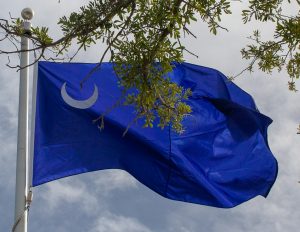
Engraving shows British ships firing on Fort Sullivan in the Battle of Sullivan’s Island. Engraving via the Library of Congress.
By Andy Brack, editor and publisher | All South Carolinians today should toast the courage and mettle of patriots from 245 years who vanquished the powerful British navy in the Battle of Sullivan’s Island and secured the first major colonial victory in the Revolutionary War.
 It’s a great story of underdogs in an unfinished palmetto log-and-sand fort with 31 cannons who repelled nine man-of-war ships with almost 300 cannons. The victory by South Carolina patriots on June 28, 1776, showed leaders in colonies up and down the east coast that the cause for freedom from Britain’s tyranny was winnable. It inspired them to sign something else important in those times — the Declaration of Independence.
It’s a great story of underdogs in an unfinished palmetto log-and-sand fort with 31 cannons who repelled nine man-of-war ships with almost 300 cannons. The victory by South Carolina patriots on June 28, 1776, showed leaders in colonies up and down the east coast that the cause for freedom from Britain’s tyranny was winnable. It inspired them to sign something else important in those times — the Declaration of Independence.
Colonists started building a fort on Sullivan’s Island in February 1776 after news of plans the British wanted to capture Charleston, then one of the richest ports in the Americas. Taking Charleston, British leaders thought, would split the colonies, take away revenue fueling the patriot cause and help them quell an insurrection.
According to the S.C. Encyclopedia, the fort protecting Charleston harbor was to be square with 500-foot-long walls with a bastion at the corners. Builders placed thousands of palmetto logs in two parallel walls that were 16 feet apart. In between the walls was sand and more sand. By the end of June, only two walls and bastions were complete. Some 400 soldiers were stationed at the unfinished fort. Another 300 were at the north end of the island to keep British marines from crossing Breach Inlet.
 On June 8, the British demanded a surrender, which was rejected and led to British troops landing on what is now Isle of Palms. On June 28, warships advanced on the fort and started firing just before noon; the fort’s guns responded. Soon, three ships tried to sneak between the island and mainland to fire on the unprotected rear of the fort and block reinforcements. But they ran aground. While two later were freed from sandbars, one eventually was set afire.
On June 8, the British demanded a surrender, which was rejected and led to British troops landing on what is now Isle of Palms. On June 28, warships advanced on the fort and started firing just before noon; the fort’s guns responded. Soon, three ships tried to sneak between the island and mainland to fire on the unprotected rear of the fort and block reinforcements. But they ran aground. While two later were freed from sandbars, one eventually was set afire.
The cannonade continued through the evening, but the little fort survived with little damage, in part because of how the interwoven fibers of the palmetto logs, plus the thick berm of sand, absorbed the shock of British volleys. The non-pliable wooden ships, however, weren’t as lucky. Several were damaged in the nine-hour battle and British troops had more than 200 casualties, compared to 40 patriots. It wasn’t long before the Royal Navy withdrew and the unnamed fort was named to honor Col. William Moultrie, its commander. Now, the site is part of Fort Sumter and Fort Moultrie National Historical Park.
Visitors should learn more about the Revolutionary history of the state, rather than focus on the Civil War that some still seem to be fighting. Had it not been for the patriot victory at Sullivan’s Island plus the scores of skirmishes and battles in the Carolinas that stretched the British supply lines, the patriot cause might not have been successful.
Just look at a few names from South Carolina that are familiar to Revolutionary War junkies:
- Henry Laurens, the merchant and slave trader who helped to bankroll revolutionary fervor and who succeeded John Hancock as president of the Second Continental Congress.
- His son, John Laurens, who was a key aide to General George Washington.
- Christopher Gadsden, the organizer best known today for his “Don’t Tread of Me” flag.
- General Francis “Swamp Fox” Marion, whose guerilla tactics kept British and Loyalist forces on constant edge.
- General Thomas “Gamecock” Sumter, another guerilla leader known for furious attacks.
As you lift a glass to these leaders who put all on the line for a new country, let’s try to do a better job in capturing their spirits in the modern day so we can be just as proud of how we’re working to improve education, boost health care, reduce poverty and increase economic opportunity as we are of our history.
Andy Brack is editor and publisher of Charleston Currents, and publisher of the Charleston City Paper. Have a comment? Send to: editor@charlestoncurrents.com.



 We Can Do Better, South Carolina!
We Can Do Better, South Carolina!

























One Comment